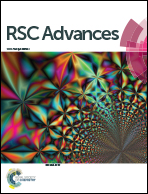The diurnal variability of sulfate and nitrate aerosols during wintertime in the Indo-Gangetic Plain: implications for heterogeneous phase chemistry†
Abstract
We have conducted this study (November 09–February 10) during the daytime (average PM1: 113 μg m−3; n = 51) and nighttime (average PM1: 159 μg m−3; n = 49) in the Indo-Gangetic Plain (IGP). Air-mass back trajectories suggest the impact of local emission and long-range transport (predominantly from the north–west direction). Mass fractions of SO42− and NO3− in PM1 are significantly (p < 0.05) different during both the daytime and nighttime, whereas NH4+/PM1 were similar during the day and night. The relatively high concentration of SO42− observed during the daytime was explained based on heterogeneous-phase reactivity due to the positive response of Fe and Mn species (inferred from correlation and multi-linear regression analysis: MLRA). Likewise, the lower concentration of NO3− was explained based on the negative response of Fe during heterogeneous phase formation. The role of wet-bulb temperature and solar flux has also been studied. From the field-based measurements our study shows that heterogeneous formation of SO42− (involving Fe and Mn) and NO3− occur via selective endothermic pathways. The proposed mechanism for sulfate and nitrate formation via heterogeneous phase reactivity is in good agreement with the field-based measurements obtained during this study (IGP). The impact of the heterogeneous-phase reactivity via endothermic pathways relates to the uptake of various reactive species during the winter in IGP. This, in turn, has implications for fog-formation and tropospheric oxidative cleansing. Furthermore, the uptake of various species will lead to altered size, morphology and optical properties of aerosols. This would have impact on regional scale radiative forcing estimates and future climate projections.


 Please wait while we load your content...
Please wait while we load your content...